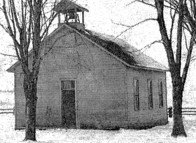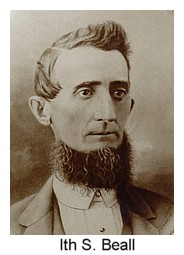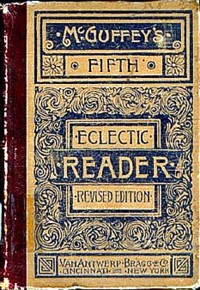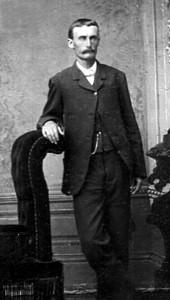|
EDUCATIONAL HISTORY of RINGGOLD COUNTY

In 1854, there was but only one school in Ringgold County. This first school building was a log cabin with a clapboard roof, erected in Section 5 of Jefferson
Township on SCHOOLER's land. Miss Orecelia KIRKHAM was the teacher and, later, Mrs. George ARGABRIGHT. Another school house was erected less than a mile from the
Iowa-Missouri border where John CUNNINGHAM taught classes. Several other areas in the county held classes in the settler's cabins
until the committees raised enough funds to finance a schoolhouse. Mount Ayr's first school held classes for two months during the fall of 1855 in a house
belonging to Judge HAGANS. In 1856, Judge HAGANS and Barton DUNNING, who established the first store in Mount Ayr, had a log school erected and gave it to the Mount Ayr school board to
use rent fee until the town could afford to buy the building. It was common practice to hire a male teacher for the
winter term when the older boys attended class, and a female teacher for the spring and summer terms.  At the Mount Ayr school, Ith BEALL (left) taught the winter term classes while Charlotte
SWAN taught the spring and summer terms. Later, they married and followed other professions. Ith was elected as the county's deputy recorder. Later, he established the
newspaper, The Ringgold Record. At the Mount Ayr school, Ith BEALL (left) taught the winter term classes while Charlotte
SWAN taught the spring and summer terms. Later, they married and followed other professions. Ith was elected as the county's deputy recorder. Later, he established the
newspaper, The Ringgold Record.
A. FOSTER taught classes in a log house located on Silas TEDROW's farm in Lotts Creek Township. Isabell POOR taught class in an old log building
in Clinton Township. Sophia ROBINSON taught classes in one-half of Jacob SMITH's log cabin located in the eastern part of the county. The first school in Grant Township was a log cabin
on the ADAMS' land where "Mother" TALLEY (Mrs. ADAMS) taught 12 students. She was paid a salary of $10 a month. In 1859, Luke SHAY and his family moved into a newly constructed frame home.
They donated their log cabin to the district for use as a school for the children of Maloy. In 1862, during the early years of the Civil War, 1,101 children were taking class in the crudely
log schools which were in session a few months out of the year. After the Civil War, the population of Ringgold County grew at such a rate that from two to four
new schoolhouses were built each season. Rollie K. BROOKS, a veteran of the Civil War, was hired to teach the winter term of 1868 at the Clipper School in Middle Fork Township. One day the
pupils asked BROOKS what kind of treat he would give them on closing day of the school term. BROOKS solemnly stated that he had no intention of treating the students. The following morning,
BROOKS arrived at the schoolhouse, finding himself locked out. The students vowed that they wouldn't unlock the door until BROOKS agreed to give them a treat on closing day. BROOKS walked away,
pretending to go back home. The boys opened the door and ran out after him. Turning quickly, BROOKS ran into the schoolhouse. At the end of the day, however, the boys waylaid BROOKS as he made
his way home. They threatened to duck him in if the creek if he did not promise to treat them as was the custom. Due to the coldness of the creek water, BROOKS promised. It is assumed the students
got their treat on closing day. Thomas A. STEVENSON taught class in a log shanty in Eugene during the fall term of 1869. One of his thirteen pupils was a former slave who was well past the age
of 21 and wanted to learn how to read. STEVENSON later purchased a farm where he raised Chester White hogs. He served as a county supervisor from 1881 to 1883 and then as Eugene's postmaster for
five years. By 1872, there were nine rural schools in Middle Fork Township. The first was probably organized shortly after the first school levy was made on the county on June 6, 1861. One of
these early schools was built in 1872 and named the Gill School, better known as Rose Hill School. On Sundays, church services were held in the school for at least twelve years or so. Sometime before
the year 1872, R. E. ASKREN, the county superintendent of schools, rallied the teachers together for the first county institute. At the time, each of the teachers were fairly independent, practically
an law unto himself when it came to curriculum and grading practices. ASKREN requested that the teachers bring slates, pencils, and McGuffey's Fifth Reader with them to the meeting. Less than
50 teachers attended each session which was conducted by Professor PIPER, the suprintendent of Delaware County's schools. From this, education in Ringgold County began to improve and become more consistent
from schoolhouse to schoolhouse. The county institute evolved into an annual four-week Normal School which met in the summer until the year 1900. In 1873, there were 2,301 pupils enrolled in 90 schools
scattered throughout Ringgold County. Only one of these schools was a log building.
 A stir arose in 1880 and 1881 when Appleton textbook salesmen came to Ringgold County and launched a campaign to convince
the various township school boards that their textbooks were a worthy replacement for the McGuffey Readers which had been used since the first schools had been established. Naturally, the McGuffey salesman fought
to hold their ground. In his thesis, The History of Education in Ringgold County, Kyle JONES noted, "The contest became very spirited. The Appleton men had been at work in the county for several months during
the fall of 1880 and had succeeded in getting their books adopted in several townships. During the winter of 1880, the feud smoldered and burst into flame again in the spring of 1881. The entire county seems to have
split into two factions over the question, which was put to a general vote in several of the districts. Rumors were rampant, and each side marshalled its supporters as for a matter of major importance. . . .On good
authority, according to the newspaper articles, it was said that Appleton agents offered 50 cents each for votes. In the Mount Ayr district, McGuffey won the day by a vote of 182 to 57 for Appleton."
A stir arose in 1880 and 1881 when Appleton textbook salesmen came to Ringgold County and launched a campaign to convince
the various township school boards that their textbooks were a worthy replacement for the McGuffey Readers which had been used since the first schools had been established. Naturally, the McGuffey salesman fought
to hold their ground. In his thesis, The History of Education in Ringgold County, Kyle JONES noted, "The contest became very spirited. The Appleton men had been at work in the county for several months during
the fall of 1880 and had succeeded in getting their books adopted in several townships. During the winter of 1880, the feud smoldered and burst into flame again in the spring of 1881. The entire county seems to have
split into two factions over the question, which was put to a general vote in several of the districts. Rumors were rampant, and each side marshalled its supporters as for a matter of major importance. . . .On good
authority, according to the newspaper articles, it was said that Appleton agents offered 50 cents each for votes. In the Mount Ayr district, McGuffey won the day by a vote of 182 to 57 for Appleton." NOTE: McGuffey
Readers were the most popular textbooks of the 1800's, containing stories intended to teach moral, religious, and ethical principals to children. Believing that the reader war had ended, The Ringgold Record
reported in January of 1881 that the Appleton salesmen had succeeded in introducing their textbooks in all except four townships, noting, "The Record has no choice, but believes that one kind ought to be in use
all over the county, as the teachers shift about from one district to another, and could do better work if they were not compelled to teach from different authors." In March, The Ringgold Record reported, "The
school war is revived again. It appeared to be about like the stock market in Wall Street, first one side up to the top, and then the other. Now, the McGuffey men are ahead." A township meeting was called at the Maloy
schoolhouse with the provision that only residents within the district would be permitted to speak out on the textbook matter. At the conclusion of the meeting, the McGuffey readers won. The people of Benton Township
voted in favor of McGuffey's Readers dispite the fact that Appleton and Company held a three-year contract with the township. As each township cast their votes. McGuffey reigned supreme. 100 rural schools were reported
to be in session in 1884 within Ringgold County's 33 independent districts. Of these school, only nine were graded schools. It had been said that graduation from grammar school occured when a pupil began to wear long pants.
Grading was a problem that hounded the county school superintendent throughout the 1890's and early 1900's. In 1884, 1,616 out of the county's 4,917 children of school age attended classes taught by 219 men and women. A teacher's
salary averaged $34.45 for men and $26.35 for women. Around the year 1893, the Kellerton School District bonded $1,700 for the construction of a new school. In 1885, the Tingley School District erected such a fine school building
that is was used as a model for other school buildings which were raised later on. The Redding School was built in 1887 and then in 1889 built a new two-story, three-room schoolhouse which was utilized until 1915. Knowlton was one
of the first schools in Ringgold County which established a substantial library. During the second decade of the 1900's, several school districts in Ringgold County considered consolidation. Although the citizens of Redding School
District voted in favor of consolidation in 1913, the vote was cast out on a technicality. The following year, a new school was erected in Redding. In 1915, another election was held in Redding and the citizens again voted to consolidate.
In 1917, a large addition was constructed to accomondate an increase in pupils attending the Redding School. In 1915, the residents of Delphos voted to consolidate; Maloy residents voted for consolidation in 1917; and the Beconsfield residents
cast their vote for consolidation in 1920. Although the residents of Ellston voted to consolidate, it was annulled on a technicality when the bonding company realized that the election notice had been advertised solely by public notices and not
published in the newspaper. A second vote was called which resulted in a vote against consolidation. By 1938, one-fifth of the school population of Ringgold County attended the Mount Ayr schools. Lora E. (LAUGHLIN) RICHARDSON was the first
graduate of Mount Ayr High Schools. She also was the first woman to hold the office of Ringgold County superintendent of school.  J. W. WILKERSON (left), principal of Mount Ayr School from 1886 to 1895, and Adam PICKETT, Mount Ayr principal from 1900 to
1908, were a major influences the school's progression into prominence. The school refused to join the athletic leagues of larger schools so that the students could continue to participate in games with other Ringgold County pupils attending
area smaller schools.
J. W. WILKERSON (left), principal of Mount Ayr School from 1886 to 1895, and Adam PICKETT, Mount Ayr principal from 1900 to
1908, were a major influences the school's progression into prominence. The school refused to join the athletic leagues of larger schools so that the students could continue to participate in games with other Ringgold County pupils attending
area smaller schools.
The Schoolman's Club of Ringgold County was organized in 1925, an outgrowth of the early annual teacher's meetings and Normal School. This organization became the policy maker with regard to the county's cooperative
educational system. The organization also supervised the county's basketball and baseball tournaments, the county youth conference, the county elementary reading and spelling contest, and the county music festival. The first Ringgold County
Music Festival was held on April 22, 1936 in the Mount Ayr Methodist Church. 225 student musicians from the county's ten high schools participated. In 1937, 500 student musicians participated in the festival. A rural grade school chorus was taught by
Dr. C. A. FULLERTON of Iowa State Teachers College. Dr. FULLERTON devised a method, nationally known as the "Iowa Plan," in which rural school pupils learned songs by listening to phonograph records. Each child who was above the third grade level was
tested. If the child could sing ten randomly selected songs from the phonograph collection, he or she became a member of the county chorus. By 1937, 300 Ringgold County grade school children sang under Professor FULLERTON's personal direction. During
summer vacation, the Beaconsfield School sponsored a weekly 10-cent movie. This venture proved to be highly successful. The "Irish" of Maloy won their way to the Iowa State basketball tournament in 1930. The Diagonal team, under the coaching direction of
"Pop" VARNER were the 1938 Iowa State Champions. This team was the runner-up state champions in 1939. Diagonal represented its section at the State tournament for seven out of eight years. An addition to the Mount Ayr High School was made in 1936 to provide a auditorium and gymnasium for the 500+ pupils.
The old portion of the school was remodeled at the same time.
Source:
Ringgold County History Compiled and written by the Iowa Writers' Program of the Work Projects Administration in the State of Iowa, Sponsored
by Ringgold County Superintendent of Schools, Mount Ayr, Iowa. 1942.
Written & Submitted by Sharon R. Becker, 2007
Twice-A-Week News
Mount Ayr, Ringgold County, Iowa, 1898
Ringgold County's Schools
If there is any one thing of which the people of Ringgold county have cause to be proud it is their
public schools. With 136 schoolhouses, 158 schools, including six graded schools conducted by able instructors, their
pride is not only pardonable but just. And if, with all the golden opportunities afforded by these schools, the young of
the county shall remain uneducated, their ignorance will be indeed unpardonable.The largest
school in the county, that at Mt. Ayr, will be fulled treated in this issue by an article from Principal, Professor J.
Everett SMITH. The Tingley schools have been ably conducted by Professor SANDERS for the past five years, and while we
deem the general management of the school most excellent, we are especially pleased by the Pollard system of reading and
spelling as taught in the primary department. The same system as it was taught in the Redding school is highly
commendable. Kellerton may well be proud of her new school building, and with Professor CHERRYHOLMES at the head of her
schools, we expect nothing but success. Miss MILLER has been so successful in her principalship of the
Ellston schools that another department has been added, and Diagonal, under the skillful management of Miss BLAKESLEY also
finds another pepartment a necessity. The work of Professor TALBERT has been so perfectly satisfactory to the people of
Knowlton that his services as principal of their school for the coming year have been secured.
In the country our schoolhouses are situated two miles apart, on the most beautiful sites that can be procured and in time,
when the directors have planted sufficient trees, they will be surrounded by beautiful groves. Our county normal
[school for the teachers and educators] will be held at Mt. Ayr, commencing August 3, and will continue two weeks. We hope
to see every teacher present, since we expect all who do not hold state certificates to pass the examination, as
two additionals studies, civics and economics, have been added to the list. We expect to have a very interesting normal,
not for the purpose of cramming for the examination, but to instruct and advise with teachers how to organize, manage and
control schools, and how to properly care for the health, comfort, general culture and moral elevation of their pupils.
And then there are the children. What would the schools be without them! In their bright eyes and intelligent faces
we can read the destiny of our country. And the parents of these bright children; we know they
are ready to do everything in their power to aid the work; ready to visit, to help, to encourage the teacher, to give of their means
to promote this great work of education. We feel assured with the intelligent class of people in our county and their
willingness to lend a helping hand, that the schools of Ringgold county will in the near future be second to none in the
state. Transcription by Sharon R. Becker, May of 2010
|